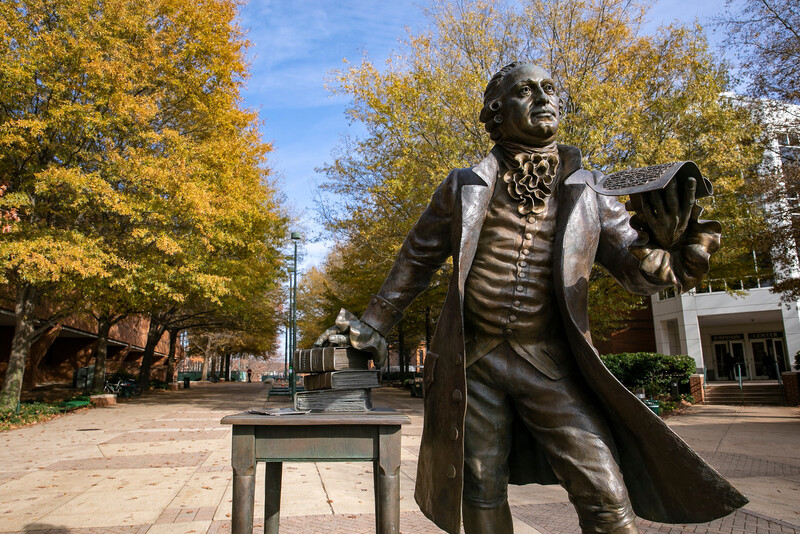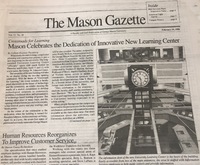George Mason Statue
"The student of George Mason learns quickly that the reputation accorded to our namesake by history is wholly disproportionate to the role he played in the formation of America."
- John Reosti, Broadside
George Mason is a U.S. founding father that is most famously remembered for his refusal to sign the U.S. Constitution, creation of the Virginia Constitution, and lastly, the famous Virginia Declaration of Rights. However, what sets Mason apart from many of his founding father counterparts is that Mason was primarily self-educated, relying on his uncle's (John Mercer) library instead of attending college for a formal education. It was through this unconventional method that George Mason familiarized himself with English law and history (as demonstrated by the books resting underneath his hand) and was crucial in the development of his convictions for freedom with liberty for all men. In addition to these accomplishments, public memory tends to focus less on his authorship of the Virginia Nonimportation Resolutions of 1769 and the Prince William County and Fairfax County resolves of 1774. [1]
In an effort to honor his accomplishments, on April 12, 1996 at 2pm, George Mason University made history by creating the first 3-D depiction of George Mason in the country. The dedication of the seven-plus feet statue occurred during the celebration and commemorance of the newly constructed Johnson Center. [2] [3]
The artist, Wendy Ross, expresses that the process for creating the statue was extremely rigorous as most people generally refer to a painting of George Mason in his thirties; however, she chose to envision Mason in his fifties, a time she claims was his most influential. [4][5] To reflect "George Mason the scholar, the statesman, and land owner," Ross positioned the statue in an up-right position with one hand resting on a stack of his intellectual inspirations (Hume, Locke, and Rousseau); Mason's left arm is extended towards the spectator as if offering the Virginia Declaration of Rights. [6] Clearly, based on her explanation, Ross is attempting to communicate through Mason's posturing the importance of his work in securing the individual freedoms that contemporary Americans revere as a foundational piece of our democracy.
[1] "George Mason: 'One of our truly great men and of the first order of greatness,'" 3 December 1990, Broadside, Box 25, George Mason University List of University and Student Publications, Special Collections Research Center, George Mason University, Fairfax, Virginia.
[2] A second dedication was held by the Virginia Daughters of the American Revolution to celebrate their contribution to its erection. On May 7th, 1996, Mrs. Stephen R. Hunter (Virginia State Regent) held the second dedication ceremony for the statue as well as a dedication of a tree in George Mason's name.
"District V, Virginia Daughters of the American Revolution: Support the State Regent's Project," Daughters of the American Revolution Magazine, January 1997, 36-37.
[3] "Mason Celebrates the Dedication of Innovative New Learning Center," 19 February 1996, The Mason Gazette, Box 81 (90), George Mason University List of University and Student Publications, Special Collections Research Center, George Mason University, Fairfax, Virginia.
[4] "Wendy Ross studied at the University of Wisconsin and San Francisco Art Institute and later received as Master of Fine Arts from the Rhode Island School of Design." At the time, Ross had acquired an extensive resumé and was internationally known for her corporate and public portraits. Some of her prior experiences included: U.S. Supreme Court, U.S. Capitol, and the National Park Service.
"Mason Sculpture Commissioned for Campus," 03 November 1995, The Mason Gazette, Box 81 (90), George Mason University List of University and Student Publications, Special Collections Research Center, George Mason University, Fairfax, Virginia.
[5] "George Mason Statue Design Approved," 11 December1992, The Mason Gazette, Box 81 (90), George Mason University List of University and Student Publications, Special Collections Research Center, George Mason University, Fairfax, Virginia.
[6] Ibid.

